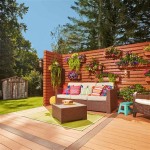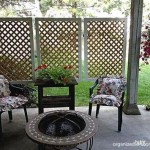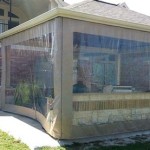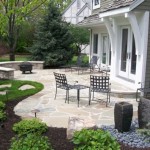Designing The Perfect Patio Decking
The design and construction of a patio decking area represent a significant undertaking that can dramatically enhance the functionality and aesthetic appeal of a home's outdoor space. Careful planning and meticulous execution are crucial for achieving a durable, visually pleasing, and user-friendly deck. This article explores key considerations involved in designing the perfect patio decking, providing a comprehensive overview of essential aspects from material selection to layout design.
Material Selection: Durability, Aesthetics, and Budget
The choice of decking material forms the foundation of the entire project. Several options exist, each possessing distinct characteristics that impact durability, aesthetics, and overall cost. The most common materials include wood (both natural and treated), composite decking, and occasionally, alternative materials like aluminum or recycled plastic.
Natural Wood: Traditional wood decking, such as redwood, cedar, and pressure-treated pine, offers a classic and natural aesthetic. Redwood and cedar are known for their inherent resistance to decay and insects, contributing to their longevity. However, these woods often require regular maintenance, including staining and sealing, to prevent weathering, warping, and rot. Pressure-treated pine is a more affordable option but often lacks the visual appeal of redwood or cedar. It also requires consistent treatment to maintain its protective properties against the elements and pests.
Composite Decking: Composite decking, made from a blend of recycled plastics and wood fibers, provides a low-maintenance alternative to natural wood. It resists fading, staining, scratching, and insect damage, making it an ideal choice for homeowners seeking a durable and long-lasting option. While composite decking typically carries a higher initial cost compared to pressure-treated wood, its reduced maintenance requirements often result in long-term cost savings. Furthermore, composite decking offers a wide variety of colors, textures, and grain patterns, allowing for greater design flexibility.
Alternative Materials: Other materials, such as aluminum and recycled plastic, offer unique advantages in specific applications. Aluminum decking is lightweight, durable, and resistant to corrosion, making it suitable for coastal environments. Recycled plastic decking is environmentally friendly and highly resistant to moisture and insects. However, these materials may have a higher upfront cost and may not replicate the natural aesthetic of wood or composite decking, depending on the specific product.
When choosing a decking material, it’s crucial to consider the local climate, intended usage of the deck, personal aesthetic preferences, and budget constraints. Evaluating these factors prior to making a final decision will help ensure that the chosen material meets the specific needs and requirements of the project.
Layout Design: Functionality and Flow
The layout of the patio decking significantly impacts its functionality, usability, and aesthetic integration with the surrounding landscape. A well-designed layout optimizes space utilization, enhances traffic flow, and complements the architectural style of the home.
Size and Shape: The dimensions of the decking area should be proportionate to the size of the yard and the intended purpose of the deck. A small deck might be sufficient for a cozy seating area, while a larger deck may be necessary for entertaining guests, outdoor dining, or accommodating a hot tub. The shape of the deck should also be considered. Rectangular decks are common and straightforward to construct, but more complex shapes, such as L-shaped or multi-level decks, can add visual interest and create distinct zones for different activities.
Zoning: Dividing the deck into distinct zones can enhance its functionality. A designated dining area with ample space for a table and chairs, a lounging area with comfortable seating, and a grilling area positioned away from high-traffic zones can create a more versatile and enjoyable outdoor space. Consider traffic patterns when dividing the deck into zones to ensure that people can move freely without disrupting other activities.
Integration with the Landscape: The deck should seamlessly integrate with the surrounding landscape. Consider incorporating natural elements, such as plants, trees, and water features, into the deck design to create a harmonious transition between the indoor and outdoor spaces. Using steps or ramps to connect the deck to the yard can further enhance accessibility and visual appeal. Pay attention to views and sight lines when designing the layout. Position the deck to take advantage of scenic views while minimizing exposure to undesirable elements, such as street noise or unsightly structures.
Building Codes and Regulations: Before finalizing the layout design, it is imperative to consult local building codes and regulations. These regulations may specify minimum clearances from property lines, height restrictions, and requirements for railings and stairs. Compliance with building codes is essential to ensure the safety and legality of the deck construction.
Structural Considerations: Foundation and Framing
The structural integrity of the patio decking is paramount for ensuring its safety, stability, and longevity. A properly designed and constructed foundation and framing system will support the weight of the decking material, furniture, and occupants, while withstanding the forces of nature.
Foundation: The foundation of the deck typically consists of concrete footings or piers that extend below the frost line to prevent movement due to freezing and thawing cycles. The size and spacing of the footings depend on the size and weight of the deck, as well as the soil conditions. In areas with unstable soil, it may be necessary to use deeper or wider footings to provide adequate support. The footings should be level and evenly spaced to ensure that the deck is stable and does not settle unevenly over time.
Framing: The framing system, consisting of beams, joists, and posts, provides the structural support for the decking surface. The size and spacing of the framing members depend on the span between the supports and the anticipated load. Pressure-treated lumber is typically used for framing to resist decay and insect damage. The framing members should be properly connected using appropriate fasteners, such as bolts, screws, and nails, to ensure a strong and rigid structure. Joist hangers are commonly used to attach joists to beams, providing a secure and reliable connection.
Drainage: Proper drainage is essential to prevent water from accumulating under the deck, which can lead to rot, mold growth, and structural damage. The deck should be sloped slightly away from the house to allow water to drain freely. A drainage system, consisting of gravel, perforated pipes, or a drainage fabric, can be installed under the deck to collect and redirect water away from the foundation. Ventilation is also important to prevent moisture buildup under the deck. Openings should be provided in the skirting or lattice to allow air to circulate freely.
Railings and Stairs: Railings and stairs are essential safety features for decks that are elevated above the ground. Railings should be at least 36 inches high and should be designed to prevent children and pets from falling off the deck. Stairs should have a comfortable rise and run and should be equipped with handrails for added safety. Building codes typically specify requirements for the height and spacing of railings and stairs.
In conclusion, designing the perfect patio decking demands a comprehensive approach that considers material selection, layout design, and structural integrity. By carefully evaluating these factors and adhering to best practices, homeowners can create an outdoor space that is both functional and aesthetically pleasing, enhancing the value and enjoyment of their property.

Simple Deck Design Ideas To Improve Your Outdoor Space Gnh

21 Small Deck Ideas To Elevate Your Outdoor Space Timbertech

Deck Ideas 40 Ways To Design A Great Backyard Or Patio Sunset

25 Deck Design Ideas To Upgrade Your Backyard Trex

15 Gorgeous Deck And Patio Ideas You Can Diy Family Handyman

Key Measurements For Designing Your Perfect Patio

Ultimate Guide To Designing Your Perfect Garden Decking Arbordeck

Maximize Your Space Deck Building Tips For The Perfect Backyard Rinaldi Roofing

Deck Ideas 40 Ways To Design A Great Backyard Or Patio Sunset

How To Decorate And Design The Perfect Outdoor Decking Area Betterdecorating
Related Posts








